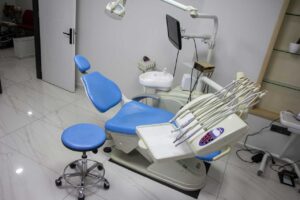
Gum disease, also known as periodontal disease, is a common oral health issue that affects millions of people worldwide. It ranges from mild cases of gum inflammation to severe conditions that can lead to tooth loss. Despite being highly preventable and treatable, gum disease often goes unnoticed until it progresses to an advanced stage.
In this comprehensive guide, we’ll delve into the symptoms, causes, and treatment options for gum disease, along with practical tips for prevention.
Seeking expert dental care for gum disease? Visit Our Website for personalized advice and treatment options.
What is Gum Disease?
Gum disease is an infection of the tissues that surround and support your teeth. It’s primarily caused by the buildup of plaque, a sticky film of bacteria that forms on teeth. If not removed through regular brushing and flossing, plaque hardens into tartar, which irritates the gums and leads to inflammation.
Stages of Gum Disease
- Gingivitis:
- The earliest stage.
- Characterized by redness, swelling, and bleeding of the gums.
- Reversible with proper oral hygiene and professional cleaning.
- Periodontitis:
- Advanced stage where the infection affects the bone supporting the teeth.
- Can cause gum recession, loose teeth, and eventual tooth loss if untreated.
Symptoms of Gum Disease
Recognizing the early signs of gum disease is crucial for timely treatment.
Common Symptoms
- Red, swollen, or tender gums.
- Gums that bleed during brushing or flossing.
- Persistent bad breath (halitosis).
- Receding gums, making teeth appear longer.
- Loose or shifting teeth.
- Pain while chewing.
- Pus around the teeth and gums (in severe cases).
If you notice any of these symptoms, consult a dentist immediately.
Need professional guidance? Book an appointment.
Causes of Gum Disease
Several factors contribute to the development of gum disease:
Poor Oral Hygiene
- Failure to brush and floss regularly allows plaque and tartar to build up, leading to infection.
Smoking and Tobacco Use
- Weakens the immune system, making it harder for gums to fight infection.
Hormonal Changes
- Pregnancy, menopause, and puberty can make gums more sensitive and prone to inflammation.
Medical Conditions
- Diseases like diabetes, heart disease, and certain autoimmune disorders increase the risk of gum disease
Genetics
- A family history of gum disease can make you more susceptible.
Poor Diet
- A diet lacking in essential nutrients weakens the immune system and gum tissue.
Risk Factors for Gum Disease
Understanding risk factors can help you take preventive measures.
Lifestyle Factors
- Stress: Impairs the body’s ability to fight infection.
- Poor hydration: Reduces saliva production, which is essential for washing away bacteria.
Dental Factors
- Crooked teeth: Create hard-to-reach areas that accumulate plaque.
- Ill-fitting dental appliances: Cause irritation and make cleaning difficult
Diagnosing Gum Disease
Early diagnosis is key to successful treatment. Dentists use several methods to assess the severity of gum disease:
1. Visual Examination
- Check for gum redness, swelling, and recession.
2. Measuring Pocket Depths
- A probe is used to measure the depth of the space between the gums and teeth.
- Healthy gums have pocket depths of 1–3 mm; deeper pockets indicate gum disease.
3. X-Rays
- Detects bone loss around teeth.
4. Reviewing Medical History
- Identifies contributing factors like smoking or systemic diseases.
Treatment Options for Gum Disease
The treatment for gum disease depends on its stage and severity.
# Professional Cleaning (Prophylaxis)
- Removes plaque and tartar from above and below the gum line.
- Recommended for mild gingivitis.
#Scaling and Root Planing (Deep Cleaning)
- Scaling: Removes tartar and bacteria from teeth and gum pockets.
- Root Planing: Smooth the root surfaces to prevent bacteria from reattaching.
#Medications
- Antibiotics: Treat infections and reduce inflammation.
- Antiseptic Mouthwash: Helps control bacteria.
#Surgical Treatments
- Flap Surgery: Removes tartar from deep pockets and reshapes damaged bone.
- Bone Grafts: Rebuilds bone lost due to periodontitis.
- Soft Tissue Grafts: Restores receded gums.
#Laser Therapy
- Minimally invasive option for removing infected tissue and bacteria.
Preventing Gum Disease
Prevention is always better than cure. Here are actionable tips to maintain healthy gums:
1. Practice Good Oral Hygiene
- Brush at least twice a day with fluoride toothpaste.
- Floss daily to remove plaque between teeth.
2. Visit the Dentist Regularly
- Schedule checkups every six months.
- Professional cleanings remove tartar that brushing and flossing can’t.
3. Eat a Balanced Diet
- Include foods rich in vitamins C and D, calcium, and antioxidants.
- Limit sugary and acidic foods.
4. Avoid Tobacco
- Quit smoking to reduce your risk of gum disease.
5. Manage Stress
- Practice relaxation techniques like meditation or yoga.
The Link Between Gum Disease and Overall Health
Research shows that gum disease is not just a dental issue; it’s linked to systemic health problems:
Heart Disease
- Bacteria from infected gums can enter the bloodstream and contribute to heart inflammation.
Diabetes
- Gum disease can make it harder to control blood sugar levels.
Respiratory Issues
- Bacteria from the mouth can be inhaled, leading to lung infections.
Conclusion
Gum disease is a serious condition that can lead to significant oral and systemic health problems if left untreated. By understanding its symptoms, causes, and treatment options, you can take proactive steps to protect your gums and overall health.
Maintaining gum health is crucial for overall well-being. Visit 32 Dental Care for expert care.



